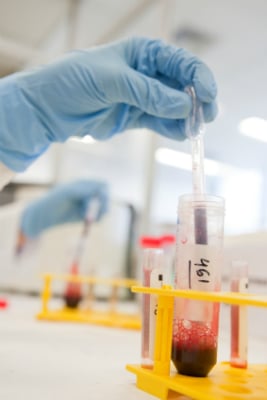
Understanding bone marrow transplants
29 August 2014
Where is bone marrow found and what function does it play in our bodies?
Bone marrow is a blood-like substance found inside our bones. It’s important because of its role in making all kinds of blood cells: red blood cells that carry oxygen, white blood cells that fight infections and platelets that help blood clot.
What is a bone marrow transplant and how will I know if my child needs one?
“There are a few reasons why a child might need a bone marrow transplant,” explains Dr. David Mitchell, Director of the Hematology-Oncology Division at the Montreal Children’s Hospital. A patient will need to have his or her bone marrow replaced when it is not working properly or has been destroyed (ablated) by chemotherapy or radiation. This “replacement” of bone marrow is referred to as a bone marrow transplant. Your child’s doctor will determine whether a bone marrow transplant is the best course of treatment given your child’s particular health status and condition.
When is a bone marrow transplant used?
Bone marrow transplants can be used as treatment in any of the following situations:
- In patients with immune deficiency disorders: since cells of the immune system are made in the bone marrow, patients with certain immune disorders may require a transplant.
- In patients with certain forms of cancer: to replace the bone marrow and restore its normal function after high doses of chemotherapy or radiation are given to treat cancer.
- In patients with rare metabolic diseases: to prevent further damage from a genetic disease process.
- In some patients with bone marrow failure: conditions where one or more of the types of cells made in the bone marrow are not produced in sufficient quantities.
- In some patients with abnormal hemoglobin molecules: hemoglobin is the molecule in red cells that carries oxygen. Transplants can help some patients with abnormal hemoglobins such as in cases where patients have been diagnosed with Thalassemia major and Sickle cell disease.
Finding a bone marrow match
Matching donors and patients is much more complex than matching blood types. Doctors match donors to patients based on their human leukocyte antigen (HLA) tissue type. HLA are proteins, or markers, found on most cells in your body. Your immune system uses these markers to recognize which cells belong in your body and which do not.
A sibling has a ¼ chance of being matched to a given patient. Well-matched unrelated adult donors can also be found through bone marrow donor registries if a compatible sibling is unavailable. If a matched sibling or well matched unrelated donor can’t be found, unmatched relatives can become donors thanks to advances in techniques and expertise. These new advances are helping to expand the pool of potential donors.
What are the sources for bone marrow cells?
“There are three potential sources from which a patient can receive cells to replace their bone marrow,” says Dr. Mitchell. These sources are:
- Bone marrow: Bone marrow is taken from the hip bones of the donor. Because the procedure is painful the donor is either asleep or receives spinal anaesthesia.
- Blood: By giving donors certain medications, the stem cells that produce blood cells can be made to go from the marrow into the blood. By performing a procedure called “apheresis” these cells can be collected directly from the blood and given to the patient. The procedure is less painful than harvesting marrow and doesn’t require anaesthesia. However, there are pros and cons to using blood instead of marrow, so the decision about which to use will be made by your child’s medical team.
- An umbilical cord blood transplant: After a baby is born, some parents decide to harvest umbilical cord blood cells from the baby’s umbilical cord and placenta. These cells are then frozen and stored until they are needed for a transplant. Umbilical cord blood cells can be stored in banks for private or public use.
Both patients and family members can have questions and concerns about when a bone marrow transplant is done. Being prepared and knowing what to expect can reduce anxiety for both children and parents. Parents can prepare and help children cope with a bone marrow transplant by explaining what will happen in a way that the child will understand.
